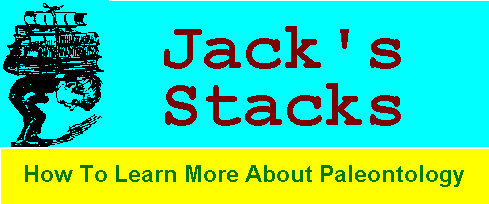
Advanced Graptolites

You're not going to believe this. Yet another work from Britain! Nigel Hughes was kind enough to lend me his copy of Fossils Illustrated, Volume 1, Graptolites: writing in the rocks, for review. Earlier this year I reviewed the second volume of the series, Trilobites, by H. B. Whittington. Graptolites, edited by Douglas Palmer and Barrie Rickards, 1991, is also published by The Boydell Press at the same $79.00 price.
Graptolites is written by numerous authors, which in itself is not unusual. All of the authors and the editors are members of a group known as "BIG G", the British and Irish Graptolite Group. These folks are serious about their graptolites!
The editors have chosen an interesting organization for the book. Each chapter title is a question that one might ask an expert about graptolites, e.g., chapter three, "How are they constructed and what are they made of?" The chapter text naturally answers the question. Since graptolites have only one probable group of living relatives, the hemichordate pterobranchs, some of the "answers" are speculative. The authors are all quite clear in separating fact from supposition.
Overall organization of this volume is similar to that of Trilobites. The first 166 pages are text, appendices, and plate descriptions followed by 138 plates. You'll still have the back and forth page flipping that I didn't like in Trilobites but it seemed less bothersome here. The only text figures were a few charts relating to classification and evolution.
The text is organized into fourteen chapters with the following "questionable" headings: 1) What are they? What do they look like? 2) How are they preserved? 3) How are they constructed and what are they made of? 4) Where are they found? 5) How did they live? 6) Where and when did they live? 7) How common were they? 8) What other organisms did they live with? 9) What was their sex life like? 10) What sort of life did the benthonic graptolites have? 11) How are they collected and prepared? 12) How are they classified? 13) What use are they anyway? 14) Why the controversies?
I think that if you read these headings closely you will see potential for repetition of information from chapter to chapter. This does happen and is a minor flaw (my opinion).
Graptolites is easy to read even though it necessarily uses technical terms throughout. One plus for this work is the inclusion of a glossary of terms as the first appendix. The authors have done an excellent job here in that they define terms from this book as well as ones you may find in reading works in their list of references. In addition to this glossary, technical terms are defined within the text when first used.
I found the writing style to be very informal and even humorous at times. My favorite example occurs in chapter 11 as the author describes the proper technique for splitting rocks to reveal graptolites: "The rock will not split along the bedding if you lay it on the ground and beat hell out of it, even if you strike it 'on the bedding', or even if you use a chisel." Well I thought it was funny!
I mentioned the appendices earlier and I know it will surprise you to find that they too are titled as questions: 1) What does that term mean? 2) Where are the good places to collect graptolites? 3) How do we classify them? 4) How did they evolve? 5) Where can I go for help? 6) Where can I read more on the subject? 7) Who can help me? 8) Who were the famous graptolite workers? Appendix 2 will disappoint you if you only collect in the Cincinnatian. Locations are listed worldwide. Many more localities are given for Britain and Ireland than any other country. The United States listing is extensive but Stonelick Creek is the only specific site mentioned for our area. Two papers are listed for reference to find other Ohio and Indiana sites. "Who can help me?", appendix 7, won't do you much good either unless you want to travel to Britain. Other than that, most of the appendices are very useful.
The plates are done in the normal professional style in black and white but the dust jacket displays a striking color photograph of a graptolite replaced by pyrite. The photographic and specimen quality is very good. Each plate contains a scale bar (the good news) but you'll have to turn to the plate explanation page to see how long it is (the bad news). Some of the plates are high magnification SEM photos. Because of preservation and preparation techniques explained in the text, some of the pictured specimens are translucent and quite striking.
Having had only a passing interest in graptolites before reading this book, I thought that I might get bored and hadn't really considered purchasing it. Now that I have read it, I found graptolites to be quite interesting and plan on acquiring my own copy. I encourage you to investigate Graptolites as well.